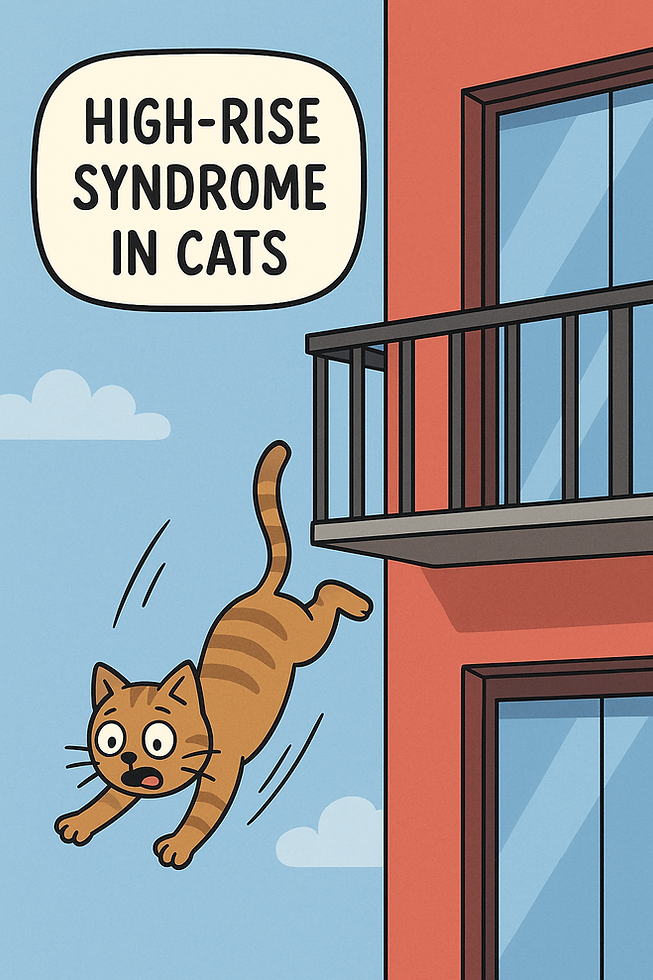
High-Rise Syndrome in Cats: Causes, Dangers, and Prevention Every Pet Owner Must Know
- shivrajclinic
- 4 days ago
- 4 min read
Cats are known for their agility and balance, often giving us the impression that they can survive any fall unharmed. But the reality is quite different. In cities across the world, veterinarians see an alarming number of cats injured from falling out of apartment windows or off balconies—a phenomenon known as High-Rise Syndrome.
This article explores what High-Rise Syndrome is, why it happens, the types of injuries it causes, and how you can protect your feline friend from such accidents.
---
What Is High-Rise Syndrome in Cats?
Definition and Overview
High-Rise Syndrome refers to a set of injuries cats sustain after falling from significant heights, typically two stories or higher. These accidents are most common in urban areas, where cats live in apartments and have access to windows or balconies.
Why It Mostly Affects Urban Cats
Cats in city apartments often live in high-rise buildings. When curious or distracted, they may fall out of open windows or slip off railings, leading to severe trauma.
---
Why Cats Fall from Heights
The Myth of “Cats Always Land on Their Feet”
Cats do have a righting reflex that allows them to twist midair and land on their feet. However, this does not mean they always escape injury. While it may reduce some damage, falls from great heights still cause broken bones and internal injuries.
Disorientation and Distraction Factors
Birds flying near windows
Sudden noises or movements
Chasing insects or toys near an edge
These distractions cause cats to lose balance and fall.
Common Situations Leading to Falls
Open windows without screens
Balconies without protective barriers
Laundry drying areas where cats like to climb
---
The Physics of a Cat’s Fall
The Righting Reflex Explained
Kittens develop the righting reflex by 6–7 weeks old. This reflex allows cats to rotate their bodies midair, but it doesn’t guarantee safety from injuries.
Terminal Velocity and Body Position
Interestingly, studies show cats may survive better from falls above seven stories than those from just two to six stories. This is because they reach terminal velocity and spread their bodies out like parachutes, reducing impact force.
Why Cats Survive Some Falls and Not Others
Shorter falls don’t give cats enough time to correct their position, while extremely high falls may overwhelm even their natural reflexes.
---
Injuries Caused by High-Rise Syndrome
Broken Jaws, Legs, and Pelvis
Fractures are among the most common injuries, often requiring surgical repair.
Chest Trauma and Lung Injuries
Cats may suffer from pneumothorax (air in the chest cavity), which can be fatal without immediate veterinary care.
Internal Organ Damage
Liver, spleen, or bladder rupture can occur, leading to life-threatening internal bleeding.
Long-Term Complications
Even after recovery, cats may suffer chronic pain, arthritis, or reduced mobility.
---
How Veterinarians Diagnose High-Rise Syndrome
Emergency Examination
A vet will first stabilize breathing and assess for shock.
Imaging: X-rays and Ultrasound
These are crucial for detecting fractures, lung injuries, and organ damage.
Blood Tests for Internal Damage
Blood work helps assess organ function and detect hidden injuries.
---
Treatment Options for Cats with High-Rise Syndrome
Emergency First Aid
Oxygen therapy, intravenous fluids, and stabilization are immediate steps.
Surgical Interventions
Fractures or ruptured organs may require complex surgeries.
Pain Management and Recovery Support
Cats need pain relief, antibiotics, and weeks of restricted movement for proper healing.
---
Survival Rates: What Studies Show
Surprising Outcomes from Multi-Story Falls
A famous 1987 New York study reported that cats falling from 32 stories sometimes survived—while falls from 2–6 stories often caused worse injuries.
Factors That Affect Recovery Chances
Height of the fall
Surface landed on (grass vs. concrete)
Immediate veterinary care
---
Prevention of High-Rise Syndrome
Cat-Proofing Balconies and Windows
Install secure screens on windows
Use netting or barriers on balconies
Indoor Enrichment Alternatives
Provide climbing trees, scratching posts, and perches to satisfy their curiosity.
Supervised Outdoor Time
Harness training and enclosed outdoor catios offer safe exploration.
---
Why Indoor Cats Are Still at Risk
Open Windows During Summer
Owners often underestimate risk when leaving windows open for ventilation.
Apartment and Balcony Living Risks
Even indoor-only cats are tempted by open spaces and can accidentally slip.
---
Common Myths About High-Rise Syndrome
“Cats Always Survive Falls”
Survival is possible but not guaranteed. Many cats die or suffer severe injuries.
“Indoor Cats Don’t Need Protection”
Even indoor cats are at risk if they live in high-rise apartments with open windows.
---
What to Do If Your Cat Falls
Immediate Steps for Owners
Stay calm
Avoid moving your cat unnecessarily
Transport them to a vet immediately
When to Seek Emergency Veterinary Care
Any fall from more than one story should be treated as an emergency—even if the cat seems fine. Internal injuries may not show immediately.
---
FAQs About High-Rise Syndrome in Cats
1. Can cats survive high falls?
Yes, but survival depends on height, landing surface, and immediate care.
2. Why do cats fall from high places?
Curiosity, distraction, or slipping while chasing prey.
3. Do all cats need screened windows?
Yes—especially in apartments and high-rise buildings.
4. Is surgery always required after a fall?
Not always, but many cats need surgical repair for fractures or organ damage.
5. How long does recovery take?
Typically 4–12 weeks, depending on injury severity.
6. Can High-Rise Syndrome be prevented?
Yes, with secure screens, supervised outdoor time, and enrichment at home.
---
Conclusion: Protecting Cats from High-Rise Syndrome
High-Rise Syndrome is preventable yet still a common emergency in urban veterinary clinics. Cats’ natural agility doesn’t make them immune to injuries from falls, and owners must take proactive measures to keep them safe.
By securing windows, providing safe enrichment, and acting quickly in emergencies, you can protect your feline companion from the dangers of high-rise living.
---






Comments